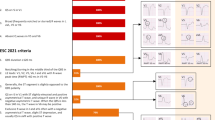Abstract
Background
Postmortem interrogation of cardiac implantable electrical devices (CIED) in autopsy is not routinely performed. Thus, it remains unclear whether an interrogation might clarify time and cause of death.
Methods
Seventy of 4401 patients (1.6%) undergoing autopsy in 2014 and 2015 presented with a CIED. The explanted CIED were interrogated with respect to time and possible cause of death. Battery and lead parameters, clinical and technical alerts, and arrhythmia episodes were reviewed and afterwards correlated with the results of autopsy and clinical data.
Results
Twenty-five implantable cardioverter defibrillators (ICD) and 45 pacemaker (PM) devices were analyzed. Death was classified as cardiac by autopsy in 17 of 70 patients. Accordingly, presumably lethal ventricular arrhythmias were documented in six patients (8.6%; 5 ICD, 1 PM). In two of 30 patients with unknown cause of death after autopsy (6.7%), interrogation revealed ventricular tachycardia as potential reason for decease (1 ICD, 1 PM). Postmortem CIED interrogation additionally allowed to make a statement regarding the day of death in 36 patients (51%; 13 ICD, 23 PM). This was in accordance with clinical data or the results of autopsy in nine patients (25%; 3 ICD, 6 PM) or could even clarify the time of death in six patients (16.7%; 4 ICD, 2 PM).
Conclusion
Interrogation of CIED revealed potentially lethal ventricular arrhythmias in 9 of 70 patients investigated and enabled valid estimation of the day of death in 15 patients. We therefore conclude that routinely performed postmortem CIED interrogation may clarify time and cause of death.




Similar content being viewed by others
References
Yu CM, Wang L, Chau E, Chan RH, Kong SL, Tang MO, Christensen J, Stadler RW, Lau CP (2005) Intrathoracic impedance monitoring in patients with heart failure: correlation with fluid status and feasibility of early warning preceding hospitalization. Circulation 112(6):841–848. https://doi.org/10.1161/circulationaha.104.492207
Gibson CM, Krucoff M, Kirtane AJ, Rao SV, Mackall JA, Matthews R, Saba S, Waksman R, Holmes D (2014) Design and rationale of the ANALYZE ST study: a prospective, nonrandomized, multicenter ST monitoring study to detect acute coronary syndrome events in implantable cardioverter-defibrillator patients. Am Heart J 168(4):424–429.e421. https://doi.org/10.1016/j.ahj.2014.05.010
Tseng ZH, Hayward RM, Clark NM, Mulvanny CG, Colburn BJ, Ursell PC, Olgin JE, Hart AP, Moffatt E (2015) Sudden death in patients with cardiac implantable electronic devices. JAMA Intern Med 175(8):1342–1350. https://doi.org/10.1001/jamainternmed.2015.2641
Priori SG, Blomstrom-Lundqvist C, Mazzanti A, Blom N, Borggrefe M, Camm J, Elliott PM, Fitzsimons D, Hatala R, Hindricks G, Kirchhof P, Kjeldsen K, Kuck KH, Hernandez-Madrid A, Nikolaou N, Norekval TM, Spaulding C, Van Veldhuisen DJ (2015) 2015 ESC guidelines for the management of patients with ventricular arrhythmias and the prevention of sudden cardiac death: the Task Force for the Management of Patients with Ventricular Arrhythmias and the Prevention of Sudden Cardiac Death of the European Society of Cardiology (ESC). Endorsed by: Association for European Paediatric and Congenital Cardiology (AEPC). Eur Heart J 36(41):2793–2867. https://doi.org/10.1093/eurheartj/ehv316
Brignole M, Auricchio A, Baron-Esquivias G, Bordachar P, Boriani G, Breithardt OA, Cleland J, Deharo JC, Delgado V, Elliott PM, Gorenek B, Israel CW, CEGftmopwvaatposcd L, Linde C, Mont L, Padeletti L, Sutton R, Vardas PE (2014) 2013 ESC guidelines on cardiac pacing and cardiac resynchronization therapy. Rev Esp Cardiol (Engl Ed) 67(1):58. https://doi.org/10.1016/j.rec.2013.11.003
Deutsche Gesellschaft für Rechtsmedizin. S1-Leitlinie 054/001. Die rechtsmedizinische Leichenöffnung. 10/2017. https://www.awmf.org/uploads/tx_szleitlinien/054-001l_S1_Die-rechtsmedizinische_Leichenoeffnung_2018-02.pdf
Sinha SK, Crain B, Flickinger K, Calkins H, Rickard J, Cheng A, Berger R, Tomaselli G, Marine JE (2016) Clinical inferences of cardiovascular implantable electronic device analysis at autopsy. J Am Coll Cardiol 68(12):1255–1264. https://doi.org/10.1016/j.jacc.2016.06.052
Nagele H, Hashagen S, Azizi M, Behrens S, Castel MA (2007) Analysis of terminal arrhythmias stored in the memory of pacemakers from patients dying suddenly. Europace 9(6):380–384. https://doi.org/10.1093/europace/eum040
Bartsch C, Irnich W, Junge M, Stertmann WA, Risse M, Weiler G (2005) Post-mortem evaluation of 415 pacemakers: in situ measurements and bench tests. Europace 7(2):175–180. https://doi.org/10.1016/j.eupc.2004.12.010
Author information
Authors and Affiliations
Corresponding author
Ethics declarations
Data collection and documentation was performed anonymously and with permission of the ethics committee of the Ludwig-Maximilians University.
Rights and permissions
About this article
Cite this article
Riesinger, L., Fichtner, S., Schuhmann, C.G. et al. Postmortem interrogation of cardiac implantable electrical devices may clarify time and cause of death. Int J Legal Med 133, 883–888 (2019). https://doi.org/10.1007/s00414-018-1932-3
Received:
Accepted:
Published:
Issue Date:
DOI: https://doi.org/10.1007/s00414-018-1932-3




